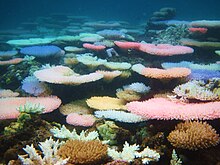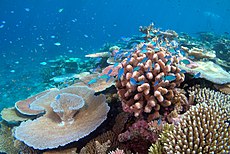Pemutihan karang
Artikel ini perlu dikembangkan agar dapat memenuhi kriteria sebagai entri Wikipedia. Bantulah untuk mengembangkan artikel ini. Jika tidak dikembangkan, artikel ini akan dihapus. |
Pemutihan karang adalah proses karang menjadi putih karena berbagai macam penyebab, seperti perubahan suhu, iklim, cahaya, dan nutrisi.[1][2] Pemutihan terjadi ketika polyp melepaskan zooxanthellae (sering juga disebut dengan algae) yang biasanya hidup di dalam tisu-tisu karang, menyebabkan karang memutih.[1] Zooxanthellae dapat berfotosintesis dan menyebabkan suhu air meningkat, sehingga mereka dapat memproduksi spesi oksigen reaktif.[2] Hal ini beracun bagi koral, sehingga koral melepaskan zooxanthellae.[2] Tisu koral menjadi transparan dan menampakkan warna tulang koral yang dibentuk oleh kalsium karbonat karena mereka melepaskan zooxanthellae yang dapat mewarnai koral.[2] Karang yang memutih umumnya tampak berwarna putih, tetapi terkadang juga berwarna biru, kuning, atau merah muda karena protein pada pigmen di dalam koral.[2]
Faktor yang paling berpengaruh adalah meningkatnya suhu laut akibat dari perubahan iklim..[3] Perubahan sebesar 1 °C dapat mengakibatkan fenomena pemutihan karang.[3] Menurut Program Lingkungan PBB, antara tahun 2014 hingga 2016, pemutihan karang secara global membunuh koral dengan jumlah yang belum pernah terjadi sebelumnya. Pada tahun 2016, pemutihan karang di Great Barrier Reef membunuh sekitar 29 hingga 50 persen dari terumbu karang disana.[4][5][6][7] Pada tahun 2017, pemutihan merambah hingga ke bagian tengah terumbu karang.[8][9] Rata-rata pemutihan telah berkurang setengah sejak 1980 hingga 2016.[10] Terumbu karang yang paling tahan terhadap fenomena ini dapat dijumpai di bagian selatan Persia/Semenanjung Arab. Beberapa dari karang disana hanya akan memutih pada temperatur diatas ~35 °C.[11][12]
Karang yang terdampak pemutihan tetap bisa hidup, tetapi karang-karang tersebut lebih rentan terserang penyakit dan kekurangan makanan.[13][14] Zooxanthellae memberikan hingga 90 persen energi pada karang,[2] sehingga karang akan kekurangan nutrisi ketika mereka melepaskan zooxanthellae.[15] Beberapa karang akan kembali seperti semula (berwarna)[1] ketika kondisi kembali normal,[13] dan beberapa karang dapat berfotosintesis.[13] Meskipun begitu, karang yang kekurangan zooxanthellae tidak dapat berfotosintesis.[13]
Pemicu[sunting | sunting sumber]
Pemutihan karang bisa terjadi karena berbagai faktor. Akibat dari meningkatnya konsentrasi karbon dioksida, karang bisa saja menjadi lebih jarang ditemukan di sistem terumbu karang.[16] Terumbu karang yang berada di perairan dangkal, suhu hangat, dan aliran air pelan lebih mudah terdampak dibandingkan dengan terumbu karang yang berada di kawasan dengan aliran air deras.[17]

- Meningkatnya suhu air (sering terjadi akibat pemanasan global), atau menurunnya suhu air[19][20][21][22]
- Meningkatnya sinar matahari (radiasi sinar matahari dan sinar ultraviolet)
- Meningkatnya sedimentasi[23]
- Infeksi bakteri[24]
- Perubahan kadar garam[25]
- Penggunaan herbisida[26]
- Penggunaan natrium sianida untuk menangkap ikan[27]
- Debu dari badai pasir Afrika[28]
- Polusi seperti oxybenzone, butylparaben, octyl methoxycinnamate, atau enzacamene: empat bahan tabir surya yang tidak dapat terurai secara alami[29][30][31][32]
- Peningkatan keasaman air laut[33]
- Polusi dari tumpahan minyak atau bahan kimia lainnya[34]
- Perubahan struktur kimia air, khususnya ketidakseimbangan rasio makronutrien nitrat dan fosfat[35]
Referensi[sunting | sunting sumber]
- ^ a b c US Department of Commerce, National Oceanic and Atmospheric Administration. "What is coral bleaching?". oceanservice.noaa.gov (dalam bahasa Inggris). Diakses tanggal 2021-09-13.
- ^ a b c d e f "CORAL BLEACHING – A REVIEW OF THE CAUSES AND CONSEQUENCES" (PDF). Diarsipkan dari versi asli (PDF) tanggal 29 Desember 2009.
- ^ a b "Corals and Coral Reefs". Smithsonian Ocean (dalam bahasa Inggris). Diarsipkan dari versi asli tanggal 18 Oktober 2020. Diakses tanggal 2019-08-15.
- ^ "Coral bleaching on Great Barrier Reef worse than expected, surveys show". The Guardian. 29 Mei 2017. Diarsipkan dari versi asli tanggal 29 Mei 2017. Diakses tanggal 29 Mei 2017.
- ^ Gilmour, J. P.; Smith, L. D.; Heyward, A. J.; Baird, A. H.; Pratchett, M. S. (2013). "Recovery of an Isolated Coral Reef System Following Severe Disturbance". Science. 340 (6128): 69–71. Bibcode:2013Sci...340...69G. doi:10.1126/science.1232310. PMID 23559247.
- ^ "The United Nations just released a warning that the Great Barrier Reef is dying". The Independent. 3 Juni 2017. Diarsipkan dari versi asli tanggal 9 Juni 2017. Diakses tanggal 11 Juni 2017.
- ^ Hughes TP, Kerry JT, Álvarez-Noriega M, Álvarez-Romero JG, Anderson KD, Baird AH, et al. (Maret 2017). "Global warming and recurrent mass bleaching of corals" (PDF). Nature. 543 (7645): 373–377. Bibcode:2017Natur.543..373H. doi:10.1038/nature21707. hdl:20.500.11937/52828. PMID 28300113. Diarsipkan dari versi asli (PDF) tanggal 12 November 2020. Diakses tanggal 12 April 2020.
- ^ "Mass coral bleaching hits the Great Barrier Reef for the second year in a row". USA Today. 13 Maret 2017. Diarsipkan dari versi asli tanggal 13 Maret 2017. Diakses tanggal 14 Maret 2017.
- ^ Galimberti, Katy (18 April 2017). "Portion of Great Barrier Reef hit with back-to-back coral bleaching has 'zero prospect for recovery'". AccuWeather.com. Diarsipkan dari versi asli tanggal 18 April 2017. Diakses tanggal 18 April 2017.
When coral experiences abnormal conditions, it releases an algae called zooxanthellae. The loss of the colorful algae causes the coral to turn white.
- ^ Hughes TP, Anderson KD, Connolly SR, Heron SF, Kerry JT, Lough JM, et al. (Januari 2018). "Spatial and temporal patterns of mass bleaching of corals in the Anthropocene" (PDF). Science. 359 (6371): 80–83. Bibcode:2018Sci...359...80H. doi:10.1126/science.aan8048. PMID 29302011. Diarsipkan dari versi asli (PDF) tanggal 28 April 2019. Diakses tanggal 25 November 2018.
- ^ Shuail, Dawood; Wiedenmann, Jörg; D'Angelo, Cecilia; Baird, Andrew H.; Pratchett, Morgan S.; Riegl, Bernhard; Burt, John A.; Petrov, Peter; Amos, Carl (2016-04-30). "Local bleaching thresholds established by remote sensing techniques vary among reefs with deviating bleaching patterns during the 2012 event in the Arabian/Persian Gulf". Marine Pollution Bulletin. Coral Reefs of Arabia (dalam bahasa Inggris). 105 (2): 654–659. Bibcode:2016MarPB.105..654S. doi:10.1016/j.marpolbul.2016.03.001. ISSN 0025-326X. PMID 26971815.
- ^ Hume, Benjamin C. C.; Voolstra, Christian R.; Arif, Chatchanit; D’Angelo, Cecilia; Burt, John A.; Eyal, Gal; Loya, Yossi; Wiedenmann, Jörg (2016-04-19). "Ancestral genetic diversity associated with the rapid spread of stress-tolerant coral symbionts in response to Holocene climate change". Proceedings of the National Academy of Sciences (dalam bahasa Inggris). 113 (16): 4416–4421. Bibcode:2016PNAS..113.4416H. doi:10.1073/pnas.1601910113
 . ISSN 0027-8424. PMC 4843444
. ISSN 0027-8424. PMC 4843444  . PMID 27044109.
. PMID 27044109.
- ^ a b c d "What is Coral Bleaching and What Causes It – Fight For Our Reef". Australian Marine Conservation Society (dalam bahasa Inggris). Diakses tanggal 2021-09-13.
- ^ "Coral Bleaching". Great Barrier Reef Foundation (dalam bahasa Inggris). Diakses tanggal 2021-09-13.
- ^ Slezak, Michael (2016-06-06). "The Great Barrier Reef: a catastrophe laid bare". The Guardian (dalam bahasa Inggris). ISSN 0261-3077. Diakses tanggal 2021-09-13.
- ^ Hoegh-Guldberg O, Mumby PJ, Hooten AJ, Steneck RS, Greenfield P, Gomez E, et al. (December 2007). "Coral reefs under rapid climate change and ocean acidification". Science. 318 (5857): 1737–42. Bibcode:2007Sci...318.1737H. CiteSeerX 10.1.1.702.1733
 . doi:10.1126/science.1152509. PMID 18079392.
. doi:10.1126/science.1152509. PMID 18079392.
- ^ Baker, Andrew; Glynn, Peter; Riegl, Bernhard (2008). "Climate change and coral reef bleaching: An ecological assessment of long-term impacts, recovery trends and future outlook". Estuarine, Coastal and Shelf Science. 80 (4): 435–471. Bibcode:2008ECSS...80..435B. doi:10.1016/j.ecss.2008.09.003.
- ^ Bollati, Elena; D’Angelo, Cecilia; Alderdice, Rachel; Pratchett, Morgan; Ziegler, Maren; Wiedenmann, Jörg (July 2020). "Optical Feedback Loop Involving Dinoflagellate Symbiont and Scleractinian Host Drives Colorful Coral Bleaching". Current Biology. 30 (13): 2433–2445.e3. doi:10.1016/j.cub.2020.04.055. ISSN 0960-9822. PMID 32442463.
- ^ "Reef 'at risk in climate change'" (Siaran pers). The University of Queensland. 6 April 2007. Diarsipkan dari versi asli tanggal 13 September 2016. Diakses tanggal 2 August 2016.
- ^ Anthony, K. 2007; Berkelmans
- ^ Saxby T, Dennison WC, Hoegh-Guldberg O (2003). "Photosynthetic responses of the coral Montipora digitata to cold temperature stress". Marine Ecology Progress Series. 248: 85–97. Bibcode:2003MEPS..248...85S. doi:10.3354/meps248085
 .
.
- ^ Marimuthu N, Jerald Wilson J, Vinithkumar NV, Kirubagaran R (9 November 2012). "Coral reef recovery status in south Andaman Islands after the bleaching event 2010". Journal of Ocean University of China. 12 (1): 91–96. Bibcode:2013JOUC...12...91M. doi:10.1007/s11802-013-2014-2.
- ^ Rogers CS (1990). "Responses of coral reefs and reef organisms to sedimentation". Marine Ecology Progress Series. 62: 185–202. Bibcode:1990MEPS...62..185R. doi:10.3354/meps062185
 .
.
- ^ Kushmaro A, Rosenberg E, Fine M, Loya Y (1997). "Bleaching of the coral Oculina patagonica by Vibrio AK-1". Marine Ecology Progress Series. 147: 159–65. Bibcode:1997MEPS..147..159K. doi:10.3354/meps147159
 .
.
- ^ Hoegh-Guldberg, Ove; Smith, G.Jason (1989). "The effect of sudden changes in temperature, light and salinity on the population density and export of zooxanthellae from the reef corals Stylophora pistillata Esper and Seriatopora hystrix Dana". Journal of Experimental Marine Biology and Ecology. 129 (3): 279–303. doi:10.1016/0022-0981(89)90109-3.
- ^ Jones RJ, Muller J, Haynes D, Schreiber U (2003). "Effects of herbicides diuron and atrazine on corals of the Great Barrier Reef, Australia". Marine Ecology Progress Series. 251: 153–167. Bibcode:2003MEPS..251..153J. doi:10.3354/meps251153
 .
.
- ^ Jones, Ross J.; Hoegh-Guldberg, Ove (1999). "Effects of cyanide on coral photosynthesis:implications for identifying the cause of coral bleaching and for assessing the environmental effects of cyanide fishing". Marine Ecology Progress Series. 177: 83–91. Bibcode:1999MEPS..177...83J. doi:10.3354/meps177083
 .
.
- ^ "Coral Mortality and African Dust". U. S. Geological Survey. Diarsipkan dari versi asli tanggal 2 May 2012. Diakses tanggal 10 June 2007.
- ^ "Protect Yourself, Protect The Reef! The impacts of sunscreens on our coral reefs" (PDF). U.S. National Park Service. Diarsipkan dari versi asli (PDF) tanggal 13 February 2013. Diakses tanggal 1 July 2013.
- ^ "Coral Reef Safe Sunscreen". badgerbalm.com. Diarsipkan dari versi asli tanggal 24 March 2014. Diakses tanggal 24 March 2014.
- ^ Danovaro R, Bongiorni L, Corinaldesi C, Giovannelli D, Damiani E, Astolfi P, Greci L, Pusceddu A (April 2008). "Sunscreens cause coral bleaching by promoting viral infections". Environmental Health Perspectives. 116 (4): 441–7. doi:10.1289/ehp.10966. PMC 2291018
 . PMID 18414624.
. PMID 18414624.
- ^ Downs CA, Kramarsky-Winter E, Fauth JE, Segal R, Bronstein O, Jeger R, Lichtenfeld Y, Woodley CM, Pennington P, Kushmaro A, Loya Y (March 2014). "Toxicological effects of the sunscreen UV filter, benzophenone-2, on planulae and in vitro cells of the coral, Stylophora pistillata". Ecotoxicology. 23 (2): 175–91. doi:10.1007/s10646-013-1161-y. PMID 24352829.
- ^ Anthony KR, Kline DI, Diaz-Pulido G, Dove S, Hoegh-Guldberg O (November 2008). "Ocean acidification causes bleaching and productivity loss in coral reef builders". Proceedings of the National Academy of Sciences of the United States of America. 105 (45): 17442–6. Bibcode:2008PNAS..10517442A. doi:10.1073/pnas.0804478105
 . PMC 2580748
. PMC 2580748  . PMID 18988740.
. PMID 18988740.
- ^ "How Do Oil Spills Affect Coral Reefs?". response.restoration.noaa.gov. Diarsipkan dari versi asli tanggal 24 April 2018. Diakses tanggal 24 April 2018.
- ^ Wiedenmann, Jörg; D’Angelo, Cecilia; Smith, Edward G.; Hunt, Alan N.; Legiret, François-Eric; Postle, Anthony D.; Achterberg, Eric P. (February 2013). "Nutrient enrichment can increase the susceptibility of reef corals to bleaching". Nature Climate Change (dalam bahasa Inggris). 3 (2): 160–164. Bibcode:2013NatCC...3..160W. doi:10.1038/nclimate1661. ISSN 1758-6798.


